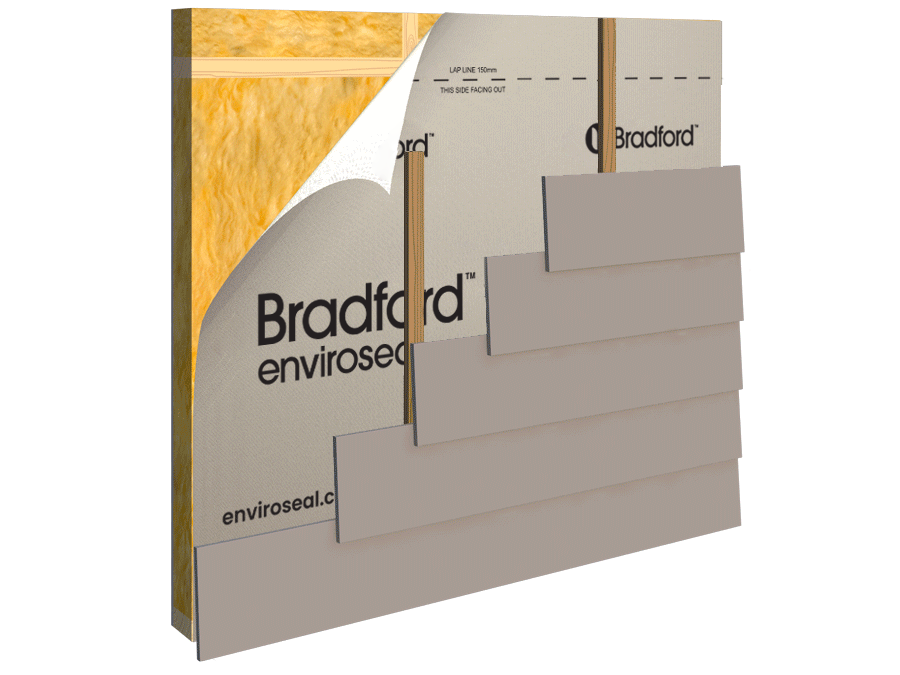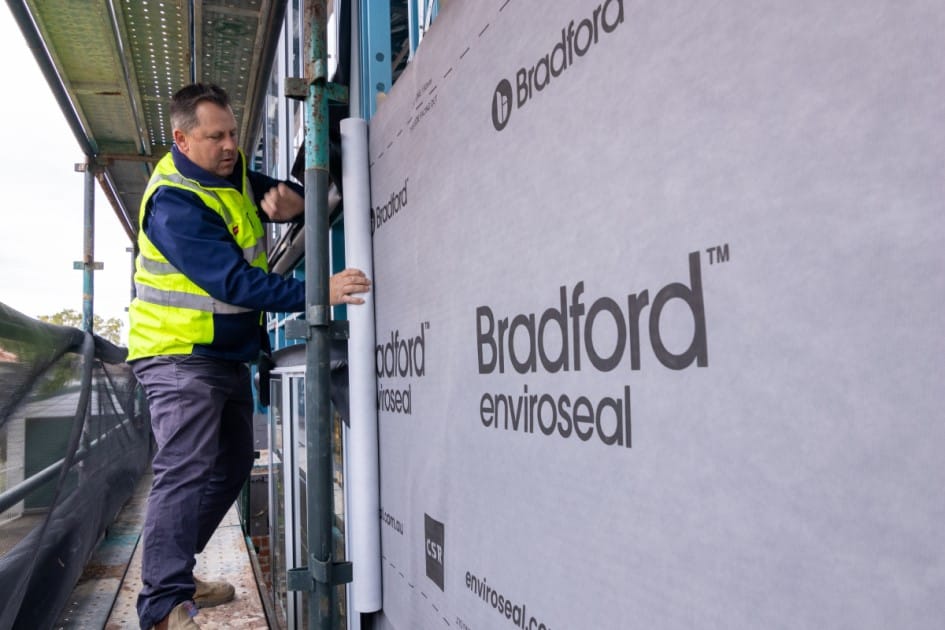Ever wondered why your new build home seems to leak heat in the winter or feel stuffy in the summer? The problem could be in the walls - literally. Have you heard builders talking about installing ‘reflective wrap’?
That ambiguous term is how some residential construction companies are avoiding taking responsibility for properly insulating and waterproofing your home.
By failing to specify the exact purpose and technical requirements of the membranes they install, like vapour barriers or air barriers, they create ambiguity that allows them to dodge compliance with building codes and regulations. You, the homeowner, end up paying the price through higher energy bills, mould risks and lower comfort. It’s time to demand clarity from builders on what’s really installed in your walls and hold them accountable so you get the high-performance, energy-efficient home you paid for.
What Are Reflective Wraps? The Ambiguity Explained
So what exactly are “reflective wraps”? The truth is, that term is ambiguous and can refer to a range of different membranes used in home construction. Builders often specify “reflective wrap” to avoid being tied down to the installation requirements of a particular product.
The Many Faces of Reflective Wrap
Reflective wraps could be:
- Vapour barriers (class 1 or 2) which control moisture
- Water control membranes that resist liquid water
- Air control layers that limit air flow
- Thermal wraps for insulation
By not specifying which type of membrane they’re using, builders can pick and choose how strictly they follow the installation guidelines. This ambiguity allows them to cut corners and avoid responsibility if problems arise down the line from improper installation.
You as the homeowner are left with a “jack of all trades, master of none” product that may not adequately serve any single purpose. The builder can claim they met the vague specification of “reflective wrap”, even if the material fails to properly control moisture, air, or insulation as needed for your home.
To avoid issues, the solution is simple. Demand specificity. Require that builders list the exact membranes, their purposes, and installation guidelines in the building contract. “Reflective wrap” just doesn’t cut it. You deserve to know exactly what’s going into the construction of your home – and to have confidence that it will do the job right. Don’t settle for ambiguity.
Why Proper Membrane Terminology Matters in Residential Construction
The terminology used for building membranes matters. When "reflective wrap" is specified by homebuilders, it creates ambiguity that allows them to avoid responsibility for proper installation and compliance.
You may not realise that pliable membranes serve very different purposes. Vapour barriers (class 1 and 2), water control membranes, air control membranes, and thermal membranes are all unique. By calling everything “reflective wrap”, homebuilders can sidestep guidelines for the correct membrane and how it should be installed.
Proper installation is key
For membranes to work as intended, they must be installed properly. Vapour barriers need to have sealed seams and edges to prevent moisture penetration, while air control membranes require attachment to the wall framing. When "reflective wrap" is listed, there are no defined installation methods to comply with. Homeowners are left with a membrane that may not suit the needs of the building envelope or be installed correctly.

The Different Types of Membranes: Vapour Barriers, Air Barriers Etc.
The building industry uses a lot of technical terms to describe the materials used in construction. Two terms that often get confused are “vapour barriers” and “air barriers”. While they may sound similar, they serve very different purposes.
A vapour barrier controls the flow of moisture vapour through walls and attics. It’s usually made of polyethylene sheeting and installed on the warm side of the insulation. The vapour barrier prevents condensation from forming within the wall cavity. Too much moisture can damage the structure and reduce the effectiveness of the insulation.
An air barrier, on the other hand, controls the unintended flow of air through the building envelope. It’s made of materials that are impermeable to air flow, like gypsum board, spray foam insulation or sealed sheathing membranes. The air barrier reduces drafts and helps improve the energy efficiency of the home. Proper air sealing can improve insulation performance by up to 30%!
Some products, like reflective insulation or “radiant barriers”, claim to function as both vapour barriers and air barriers. But the reality is that these multi-purpose products often do neither job particularly well. For the best performance, separate vapour barriers and air barriers are typically needed.
As a homeowner, it’s important to understand the difference between vapour barriers, air barriers and other membranes. Ask lots of questions about the specific products being used in your home and bes sure that your builder clearly articlulates what purpose the membrane is serving and that your contract documentation is accordingly updated to show this.
How “Reflective Wrap” Allows Builders to Avoid Compliance
When installing insulation, vapour barriers, and water control membranes, builders are required to follow strict regulations to ensure these components are installed properly based on their intended purpose. However, by specifying “reflective wrap” instead of the actual product name on building plans, builders create ambiguity that allows them to avoid compliance with these regulations.
For example, class 1 and 2 vapour barriers have specific installation instructions to prevent moisture issues, while air control membranes require different installation to improve energy efficiency. By calling these components “reflective wrap” builders are not actually defining the product’s purpose or installation requirements. This allows them to take shortcuts since there are no guidelines to follow for a generic “reflective wrap”.
The result is components that are installed incorrectly or not fit for purpose. This can lead to serious issues like mould growth, water damage or poor energy performance in the home. As the homeowner, you have no way of knowing if the proper materials and installation techniques were used since “reflective wrap” could refer to anything. By the time problems arise, the builder is long gone.
Using ambiguous terminology is an unacceptable building practice that allows builders to cut corners and avoid responsibility for shoddy workmanship. As a homeowner, you should insist on transparency regarding the actual materials and components used in your home's construction. Your investment and peace of mind depend on it.
Demanding Clarity: Getting Builders to Follow Regulations for Defined Membranes
As a homeowner, you need to demand clarity from your builder on exactly what types of waterproofing membranes, air barriers or vapour retarders are being installed in your home. Don’t let them get away with vaguely specifying “reflective wrap” without defining what class or type it is. Each membrane has a specific purpose and installation method to properly control moisture, air flow or heat transfer in residential construction.
Get Specific
Ask them to explicitly state in the building contract whether they’re using class 1, 2 or 3 vapour barriers, breather membranes, smart vapour retarders or air barriers. Each has unique properties, like permeability and installation methods, to suit your region’s climate needs. For example, using an air barrier in a heating-dominated climate could lead to condensation issues without a defined vapour retarder. Specifying one type for all construction regions is like saying it hardly rains over there so you will never need rain protection. You would take what you need for the environment you are going into the same as you would build your home to suit its building location. This sounds basic and like common sense but I can assure you it is not going on in building companies.
By avoiding defined terminology and specifications, some residential construction companies are skirting responsibility. As a homeowner, insist on clarity around which membranes are being installed and verification of proper installation. Your building envelope depends on it.
Check Installation
Once you have clarity on the exact membranes being used, check that they’re installed properly according to the product specifications and local building code requirements. Vapour barriers need to be installed on the warm side of the wall, while air barriers are installed on the exterior. Seams and edges must be sealed to avoid air leaks or moisture ingress. If the membranes aren’t installed correctly, you could face issues like mould, water damage or poor energy efficiency down the road.
Hold Them Accountable
Don’t let ambiguity around the terms “reflective wrap” or other vague product names allow builders to avoid responsibility for proper installation of defined membranes. Insist on clarity in the specifications and contracts, and consider hiring an independent building inspector to assess if the right products were used and installed correctly in your new home. Your builder needs to be held accountable to follow the regulations for the specific membranes they’re including in your home’s construction.
By demanding defined details and accountability, you’ll ensure your home’s waterproofing and insulation needs are addressed properly from the start. In the long run, it will mean fewer headaches, lower utility bills and a well-built, durable home.
Conclusion
Make sure you know exactly what kind of membranes are being used and installed in your home. Don't settle for vague terms like 'reflective wrap' that allow builders to cut corners and avoid responsibility. Demand clarity and accountability.
Your home is too important and too expensive to leave key details unclear or ambiguous. Do your research, ask questions, and don't sign off on anything until you have a full, transparent understanding of what's going into the construction of your property.
Your future comfort, energy efficiency and financial wellbeing depend on it. Knowledge is power, so empower yourself to make the best decisions for your home.







